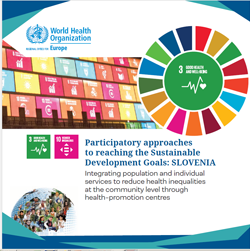Slovenia. Integrating population and individual services to reduce health inequalities at the community level through health-promotion centres (2019)

Download
In 2002, HPCs were created in all 61 PHC centres across Slovenia. Their major role was to provide lifestyle interventions against the key risk factors for noncommunicable diseases (NCDs) through a combination of population- and individual-based approaches. These centres integrated activities, which had previously been dispersed among the PHC centres, including community nursing. To better focus on vulnerable groups, between 2013 and 2016, HPC centres piloted a new approach to integrating the different services, targeting vulnerable groups at the community level. This entailed their reaching out to and involving key stakeholders with an impact on community health to ensure that vulnerable groups were not left behind. Partnerships were created with different stakeholders, including social services and nongovernmental organizations (NGOs). This resulted in the adoption of local health-promotion strategies and action plans aimed at addressing the needs of the different population groups by identifying and reducing health inequalities. Slovenia’s experience shows how they are working towards reaching SDGs 3 and 10 in order to achieve good health and well-being and leave no one behind.



